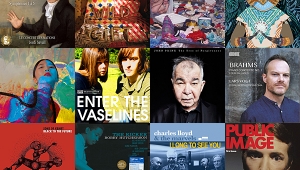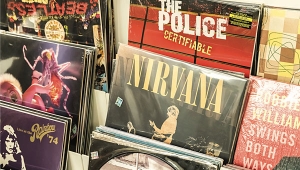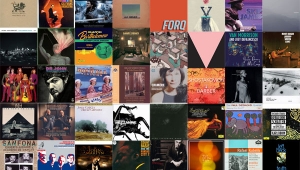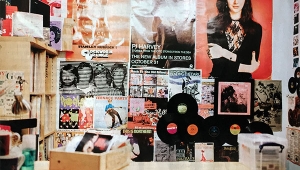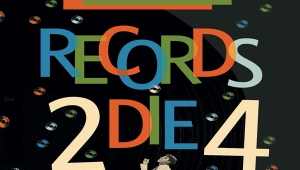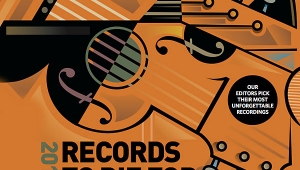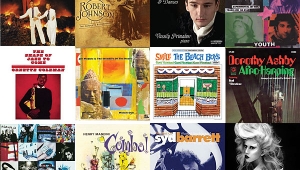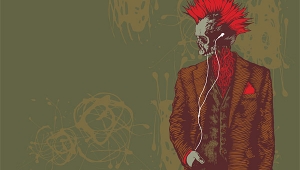| Columns Retired Columns & Blogs |
2005 Records To Die For Page 2
JOHN ATKINSON
BURT BACHARACH & RONALD ISLEY: Here I Am
DreamWorks B0001005-2 (CD). 2003. Burt Bacharach, Ted Perlman, Ronald Isley, prods.; John McClain, Ronald Isley, exec. prods.; Alan Sides, Al Schmidt, mix engs.; Steve Genewick, Tom Sweeney, asst. engs.; Wil Donovan, Jimmy Hoyson, second engs.; David Chase, ProTools eng.; Alan Yoshida, mastering eng. DDD? TT: 58:19
Ever since I heard "Anyone Who Had a Heart" in 1963—growing up in England, it was Cilla Black's cover rather than Dionne Warwick's original, of course—Burt Bacharach's songs have played a major role in the soundtrack to my life. (See my July 2003 "As We See It.") And Dusty Springfield's "The Look of Love" is, of course, one of the brightest stars in the high-end audio firmament. But in all those years, I never envisaged what a rococo-ranged R&B singer such as patriarch Ronnie, of the extended Isley family, could and would do with these standards. Piling mordant upon ornament, swoop upon flourish, trill upon turn, Ronnie Isley takes these perhaps overfamiliar melodies on journeys of unexpected harmonic exploration. His "The Look of Love," for example, begins with a melancholy figure based on the "don't ever go" and "I love you so much" tags from the chorus, overlying a stark electric piano vamp. After a fairly straight reading of the song, Isley and Bacharach construct from the opening raw material an inspirational vocal coda. Almost always, Ronnie succeeds in convincing the listener that this is how Burt intended the songs to sound, helped by the composer's lushly sparse scoring and a sound, recorded live in Hollywood's legendary Capitol Studios, that is to die for. It might verge at times on High Camp, but Here I Am is still High Art.
JONI MITCHELL: Shadows and Light
Asylum 704-2 (2 HDCDs). 1999. Joni Mitchell, prod., mix; Henry Lewy, mix, eng.; Skip Cottrell, mix; Andy Johns, Henry Lewy, engs.; Joe Gastwirt, mastering. ADD. TT: 84:00
Shout Factory DVD 30161 (DVD-V). 2003. Linear PCM & 5.1 Dolby Digital soundtracks. Tour Photo Diary. Joni Mitchell, dir. TT: 75:00
"Every picture has its shadows / and it has some source of light / blindness, blindness and light." Thus goes the gospel-inflected, Da Vinci-inspired launch of what may well rank as one of the best live concert recordings of all time: an all-growed-up Joni Mitchell weaving her musical magic at the Santa Barbara Bowl in September 1979, with a blue-chip band of Pat Metheny on guitar, Lyle Mays on synths and Rhodes piano, Don Alias on drums and percussion, Michael Brecker on tenor sax, The Persuasions on backup vocals, and the incomparable Jaco Pastorius on fretless Fender bass guitar in what is one of the few filmed performances of his tragically short career. (The 1979 tour dates and set list can be found here.) Mitchell stands revealed not only as an insightful lyricist and an eclectic melodist, but as a vocal technician fully worthy of fronting her virtuoso band as they play off of each other. Even when Jaco unleashes cascades of notes and harmonics, his contribution illuminates rather than darkens the music's message.
THE ROLLING STONES: Let It Bleed
Abkco 90042 (SACD/CD). 1969/2002. Jimmy Miller, prod.; Glyn Johns, eng.; Bruce Botnick, Jerry Hansen, George Chiantz, asst. engs. AAD? TT: 42:23
RANDY NEWMAN: Good Old Boys
Reprise/Rhino (2 CDs). 1974/2002. Lenny Waronker, Russ Titelman, prods.; Lee Herschberg, eng.; Donn Landee, asst. eng. AAD? TT: 78:39
When it comes to writing my R2D4s each year, as music editor of Stereophile I've annually felt it my duty to be lead dog in the inevitable let's-see-how-obscure-and-cool-we-can-be row that occurs when the musically literate are asked to choose favorites. This year, however, as I stood gazing on shelves of CDs, pondering my choices, I decided to get really radical and choose a couple of records—well-known, yes, overexposed, perhaps—that I've loved forever and that, known quantities or not, are two of the best collections of songwriting I've ever heard.
VAGN HOLMBOE: Sinfonias I–IV, Chairos
Hannu Koivula, Danish Radio Sinfonietta
Da Capo 8.226017-18 (CD). 2004. Peter Willemoes, prod.; Peter Bo Nielsen, eng. DDD. TT: 113:44
This two-disc set (priced as one CD) offers the late Danish composer Vagn Holmboe's four string Sinfonias in two settings. On disc 1, they come as four distinct works; on disc 2, differently ordered, they form an hour-long tone poem, Chairos. Either way, the music abounds in melodic beauty, harmonic and textural richness, and rhythmic vitality. Alternately luminous and buzzing, Chairos manages to evoke both Bartók (for the often folk-like piquancy) and Sibelius (for the organic way the material builds on itself). The Danish Radio Sinfonietta shows transcendent concentration and timbral allure. Anyone newly exploring contemporary music could do far worse than to start with this nicely packaged, immaculately recorded set.
PINK FLOYD: Dark Side of the Moon
Capitol 5 82136 2 (SACD). 1973/2003. Pink Floyd, prods.; Alan Parsons, eng.; James Guthrie, 5.1 mix eng.; Doug Sax, James Guthrie, 5.1 & stereo mastering engs. DDD. TT: 42:58
Yes, it's the all-time FM rock warhorse. Yet the SACD reissue sheds new light on Dark Side of the Moon. Arguably, there is no 5.1 surround-sound rock remix/remaster to rival Pink Floyd's disc for sheer sensual aptness. The sound effects pan around the aural picture with ear-bending immediacy, and the choir in "Us and Them" is separated to the rear for rare depth of field. But the widescreen sonic upgrade only adds luster to Pink Floyd's artistic achievement. From the opening heartbeats and sotto voce spoken word to the overwhelming climax of "Eclipse," this apotheosis of 1970s album rock has never sounded better—or seemed more moving. (XXVI-6)
BRIAN WILSON: Pet Sounds Live
Sanctuary 84556-2 (CD). 2002. Brian Wilson, prod., arr.; Mark Linett, eng.; Joe Gastwirt, mastering. DDD? TT: 43:09
One of the genuine masterpieces of the rock era, Pet Sounds had never been performed live as originally conceived by its creator, the legendary Brian Wilson. In 2001, Wilson and his musical director, Darian Sahanaja, assembled a band capable of re-creating the album's revolutionary, highly complex music and took it on the road. Recorded at the Royal Albert Hall, Pet Sounds Live finds Wilson and his amazing band creating the purest kind of magic. It's well recorded but no audiophile spectacular, and Wilson's voice occasionally sounds a bit worn, but to hear this eternally wonderful music being perfectly performed live by its visionary creator induces tingles.
FOTHERINGAY: Fotheringay
A&M SP4269 (LP). 1970. Joe Boyd, prod.; Jerry Boys, eng. AAA.
After leaving Fairport Convention following the epochal Liege and Lief, Sandy Denny formed Fotheringay with her husband-to-be, Trevor Lucas, American guitarist Jerry Donahue, and a crackerjack rhythm section. Like Fairport's, Fotheringay's sound was a British folk-rock mix of acoustic and amplified instruments. This album is a sonic delight thoroughly typical of the natural, crystalline sound Joe Boyd always strove for—guitars and voices ring out with near-perfection. Even better, it contains some of Denny's finest songs: "Nothing More," "Winter Winds," and her definitive performance of "Banks of the Nile"—so graceful, elegant, and heartbreaking that it's beyond description. A treasure in every way.
ANTOLOGÍA DEL SON DE MEXICO: Various Artists
Corason 101/3 (3 CDs). 1993. Eduardo Llerenas, Enrique Ramírez de Arellano, Baruj Lieberman, prods., engs. AAD TT: 3:25:21
American pop has deep roots—the blues, jazz, folk music, field hollers, classical song, old-timey, Cajun, gospel, and about eight zillion other substrata. Wicked as America's roots are, the music from which Mexico's mariachi genre rises—the traditional son—is a relatively untapped wellspring with some of the most complex, whippin' folk music ever recorded.
LINDA RONSTADT: Canciones de mi Padre
Mariachi Vargas de Tecalitlán, with members of Mariachi Los Camperos de Nati Cano and Mariachi Sol de México de José Hernandez Asylum 60765 (CD). 1987. Peter Asher, Ruben Fuentes, prods.; Shawn Murphy, eng. AAD. TT: 40:25
Linda Ronstadt's record company thought she was nuts when she told them she wanted to record mariachi music. And more than a few eyebrows were raised when this country-rock diva and interpreter of American standards turned her powerful pipes to Mexican ballads, heart-tugging rancheras, vaulting huapangos, and lusty drinking songs. Backed by the reputed best band in the genre, the Mariachi Vargas de Tecalitlán, Ronstadt turned in covers of tunes made famous by the likes of Lucha Reyes, Miguel Aceves Mejia, Lola Beltrán, and Pedro Infante with a just-right mix of reverence and personal interpretation. This disc of tunes, which Ronstadt first heard from her dad's record collection on Sunday afternoons growing up in Tucson, Arizona, catalyzed the explosive rebirth of mariachi music among Mexican-Americans, and brought deserved recognition to an amazing living tradition.
BURT BACHARACH & RONALD ISLEY: Here I Am
DreamWorks B0001005-2 (CD). 2003. Burt Bacharach, Ted Perlman, Ronald Isley, prods.; John McClain, Ronald Isley, exec. prods.; Alan Sides, Al Schmidt, mix engs.; Steve Genewick, Tom Sweeney, asst. engs.; Wil Donovan, Jimmy Hoyson, second engs.; David Chase, ProTools eng.; Alan Yoshida, mastering eng. DDD? TT: 58:19
Ever since I heard "Anyone Who Had a Heart" in 1963—growing up in England, it was Cilla Black's cover rather than Dionne Warwick's original, of course—Burt Bacharach's songs have played a major role in the soundtrack to my life. (See my July 2003 "As We See It.") And Dusty Springfield's "The Look of Love" is, of course, one of the brightest stars in the high-end audio firmament. But in all those years, I never envisaged what a rococo-ranged R&B singer such as patriarch Ronnie, of the extended Isley family, could and would do with these standards. Piling mordant upon ornament, swoop upon flourish, trill upon turn, Ronnie Isley takes these perhaps overfamiliar melodies on journeys of unexpected harmonic exploration. His "The Look of Love," for example, begins with a melancholy figure based on the "don't ever go" and "I love you so much" tags from the chorus, overlying a stark electric piano vamp. After a fairly straight reading of the song, Isley and Bacharach construct from the opening raw material an inspirational vocal coda. Almost always, Ronnie succeeds in convincing the listener that this is how Burt intended the songs to sound, helped by the composer's lushly sparse scoring and a sound, recorded live in Hollywood's legendary Capitol Studios, that is to die for. It might verge at times on High Camp, but Here I Am is still High Art.
JONI MITCHELL: Shadows and Light
Asylum 704-2 (2 HDCDs). 1999. Joni Mitchell, prod., mix; Henry Lewy, mix, eng.; Skip Cottrell, mix; Andy Johns, Henry Lewy, engs.; Joe Gastwirt, mastering. ADD. TT: 84:00
Shout Factory DVD 30161 (DVD-V). 2003. Linear PCM & 5.1 Dolby Digital soundtracks. Tour Photo Diary. Joni Mitchell, dir. TT: 75:00
"Every picture has its shadows / and it has some source of light / blindness, blindness and light." Thus goes the gospel-inflected, Da Vinci-inspired launch of what may well rank as one of the best live concert recordings of all time: an all-growed-up Joni Mitchell weaving her musical magic at the Santa Barbara Bowl in September 1979, with a blue-chip band of Pat Metheny on guitar, Lyle Mays on synths and Rhodes piano, Don Alias on drums and percussion, Michael Brecker on tenor sax, The Persuasions on backup vocals, and the incomparable Jaco Pastorius on fretless Fender bass guitar in what is one of the few filmed performances of his tragically short career. (The 1979 tour dates and set list can be found here.) Mitchell stands revealed not only as an insightful lyricist and an eclectic melodist, but as a vocal technician fully worthy of fronting her virtuoso band as they play off of each other. Even when Jaco unleashes cascades of notes and harmonics, his contribution illuminates rather than darkens the music's message.
The programs on the two-CD set and the rather clumsily directed DVD are not identical. Though both start with the mood-managing sequence of "In France They Kiss on Main Street," "Edith and the King Pin," and "Coyote," the CD adds a drum solo from Alias that segues into "Dreamland," and a coda of "Woodstock" and "God Must Be a Boogie Man" (taken from the PA mix), in which Pastorius playfully duets with Joni. On the other hand, the DVD includes a short but masterful solo from Pastorius, in which he sets up an ostinato figure on his echo unit in order to jam on "The High and the Mighty" and Hendrix's "Third Stone from the Sun." Goosebump sandwich!
ROBERT BAIRD
THE ROLLING STONES: Let It Bleed
Abkco 90042 (SACD/CD). 1969/2002. Jimmy Miller, prod.; Glyn Johns, eng.; Bruce Botnick, Jerry Hansen, George Chiantz, asst. engs. AAD? TT: 42:23
RANDY NEWMAN: Good Old Boys
Reprise/Rhino (2 CDs). 1974/2002. Lenny Waronker, Russ Titelman, prods.; Lee Herschberg, eng.; Donn Landee, asst. eng. AAD? TT: 78:39
When it comes to writing my R2D4s each year, as music editor of Stereophile I've annually felt it my duty to be lead dog in the inevitable let's-see-how-obscure-and-cool-we-can-be row that occurs when the musically literate are asked to choose favorites. This year, however, as I stood gazing on shelves of CDs, pondering my choices, I decided to get really radical and choose a couple of records—well-known, yes, overexposed, perhaps—that I've loved forever and that, known quantities or not, are two of the best collections of songwriting I've ever heard.
With its layer-cake cover art, immortal exhortation of "THIS RECORD SHOULD BE PLAYED LOUD," and such songwriting darts as "Midnight Rambler," "Gimme Shelter," "Let It Bleed," and my favorite, the "trifle too satanic" "Monkey Man" (Jagger's unhinged, primate-like chattering near the song's end is marvelous), this is prime Glimmer Twins. Not the overt soundtrack for a drug trip that Sticky Fingers is, Let It Bleed still has plenty of audible evidence ("all my friends are junkies") of the good times that were then being had by all. It's also the record where Brian Jones slides out and Mick Taylor moves in, and it's the home of "You Can't Always Get What You Want," the most profound story of a moral that Keef and Mick ever managed. In this new DSD remastering, the sound is better than ever. Exile on Main Street has more range and Sticky Fingers is darker, but the group of songs was never stronger.
Randy Newman's messages are of a deeper, quieter variety. In Good Old Boys, his paean to his hometown of NOLA, Newman struck his most lasting musical currency. Despite his many gifts and long trail of essential albums, Newman has never quite equaled the melodies or the words that make songs like "Birmingham," "Louisiana 1927," and "Kingfish" so powerful.
Opening with the charming, inoffensive couplet of "Last night I saw Lester Maddox on a TV show / With some smart-ass New York Jew" ("Rednecks"), Newman goes on to successfully tightrope his smart-aleck way along a knife edge between simultaneously harpooning and defending Southern society. In the aforementioned "Rednecks," the thrust is that while the South may be full of crackers ("College men from L.S.U. / Went in dumb, Come out dumb too"), the hypocrisy of the North—where everyone is free but racism also thrives—may, in the end, be worse. Newman's wry, laconic vocals, a blessed lack of novelty numbers (eg, "Short People"), and the support of such talents as Ry Cooder (guitars), Jim Keltner (drums), and three of those eternally annoying Eagles (I can't always get what I want) arguably make this the most cohesive and focused album of a brilliant career. (XXVI-1)
BRADLEY BAMBARGER
VAGN HOLMBOE: Sinfonias I–IV, Chairos
Hannu Koivula, Danish Radio Sinfonietta
Da Capo 8.226017-18 (CD). 2004. Peter Willemoes, prod.; Peter Bo Nielsen, eng. DDD. TT: 113:44
This two-disc set (priced as one CD) offers the late Danish composer Vagn Holmboe's four string Sinfonias in two settings. On disc 1, they come as four distinct works; on disc 2, differently ordered, they form an hour-long tone poem, Chairos. Either way, the music abounds in melodic beauty, harmonic and textural richness, and rhythmic vitality. Alternately luminous and buzzing, Chairos manages to evoke both Bartók (for the often folk-like piquancy) and Sibelius (for the organic way the material builds on itself). The Danish Radio Sinfonietta shows transcendent concentration and timbral allure. Anyone newly exploring contemporary music could do far worse than to start with this nicely packaged, immaculately recorded set.
PINK FLOYD: Dark Side of the Moon
Capitol 5 82136 2 (SACD). 1973/2003. Pink Floyd, prods.; Alan Parsons, eng.; James Guthrie, 5.1 mix eng.; Doug Sax, James Guthrie, 5.1 & stereo mastering engs. DDD. TT: 42:58
Yes, it's the all-time FM rock warhorse. Yet the SACD reissue sheds new light on Dark Side of the Moon. Arguably, there is no 5.1 surround-sound rock remix/remaster to rival Pink Floyd's disc for sheer sensual aptness. The sound effects pan around the aural picture with ear-bending immediacy, and the choir in "Us and Them" is separated to the rear for rare depth of field. But the widescreen sonic upgrade only adds luster to Pink Floyd's artistic achievement. From the opening heartbeats and sotto voce spoken word to the overwhelming climax of "Eclipse," this apotheosis of 1970s album rock has never sounded better—or seemed more moving. (XXVI-6)
PAUL BOLIN
BRIAN WILSON: Pet Sounds Live
Sanctuary 84556-2 (CD). 2002. Brian Wilson, prod., arr.; Mark Linett, eng.; Joe Gastwirt, mastering. DDD? TT: 43:09
One of the genuine masterpieces of the rock era, Pet Sounds had never been performed live as originally conceived by its creator, the legendary Brian Wilson. In 2001, Wilson and his musical director, Darian Sahanaja, assembled a band capable of re-creating the album's revolutionary, highly complex music and took it on the road. Recorded at the Royal Albert Hall, Pet Sounds Live finds Wilson and his amazing band creating the purest kind of magic. It's well recorded but no audiophile spectacular, and Wilson's voice occasionally sounds a bit worn, but to hear this eternally wonderful music being perfectly performed live by its visionary creator induces tingles.
FOTHERINGAY: Fotheringay
A&M SP4269 (LP). 1970. Joe Boyd, prod.; Jerry Boys, eng. AAA.
After leaving Fairport Convention following the epochal Liege and Lief, Sandy Denny formed Fotheringay with her husband-to-be, Trevor Lucas, American guitarist Jerry Donahue, and a crackerjack rhythm section. Like Fairport's, Fotheringay's sound was a British folk-rock mix of acoustic and amplified instruments. This album is a sonic delight thoroughly typical of the natural, crystalline sound Joe Boyd always strove for—guitars and voices ring out with near-perfection. Even better, it contains some of Denny's finest songs: "Nothing More," "Winter Winds," and her definitive performance of "Banks of the Nile"—so graceful, elegant, and heartbreaking that it's beyond description. A treasure in every way.
DANIEL BUCKLEY
ANTOLOGÍA DEL SON DE MEXICO: Various Artists
Corason 101/3 (3 CDs). 1993. Eduardo Llerenas, Enrique Ramírez de Arellano, Baruj Lieberman, prods., engs. AAD TT: 3:25:21
American pop has deep roots—the blues, jazz, folk music, field hollers, classical song, old-timey, Cajun, gospel, and about eight zillion other substrata. Wicked as America's roots are, the music from which Mexico's mariachi genre rises—the traditional son—is a relatively untapped wellspring with some of the most complex, whippin' folk music ever recorded.
This 59-track, three-CD set is the mother lode in terms of both scholarly introduction and glorious examples. The culmination of 20 years of research and field recordings by a trio of Mexico's foremost ethnomusicologists, this choicely curated collection, accompanied by a 36-page, finely illustrated book in English and Spanish, takes the listener on a fantastic aural tour of rural Mexico. But this is no dry thesis. If the leaping falsettos, wild-eyed fiddling, wry wit, and intricate polyrhythms of the Son Huasteca, from Mexico's northeastern coast, don't make you a rabid addict, you are a soul-free human being.
LINDA RONSTADT: Canciones de mi Padre
Mariachi Vargas de Tecalitlán, with members of Mariachi Los Camperos de Nati Cano and Mariachi Sol de México de José Hernandez Asylum 60765 (CD). 1987. Peter Asher, Ruben Fuentes, prods.; Shawn Murphy, eng. AAD. TT: 40:25
Linda Ronstadt's record company thought she was nuts when she told them she wanted to record mariachi music. And more than a few eyebrows were raised when this country-rock diva and interpreter of American standards turned her powerful pipes to Mexican ballads, heart-tugging rancheras, vaulting huapangos, and lusty drinking songs. Backed by the reputed best band in the genre, the Mariachi Vargas de Tecalitlán, Ronstadt turned in covers of tunes made famous by the likes of Lucha Reyes, Miguel Aceves Mejia, Lola Beltrán, and Pedro Infante with a just-right mix of reverence and personal interpretation. This disc of tunes, which Ronstadt first heard from her dad's record collection on Sunday afternoons growing up in Tucson, Arizona, catalyzed the explosive rebirth of mariachi music among Mexican-Americans, and brought deserved recognition to an amazing living tradition.
- Log in or register to post comments

